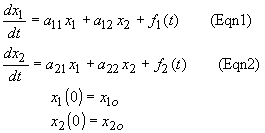General Form:
1. Some Examples of Process Modeling
- Mass Balance:
Rate of Change of Mass in System =- Component Balance:
Mass Flow Rate In - Mass Flow Rate OutRate of Change of Component j in System =- Energy Balance:
Flow of Component j In - Flow of Component j Out
+ Rate of Production of Component j
- Rate of Depletion of Component jRate of Change in Enthalpy in System =
Bulk Flow of Enthalpy In - Bulk Flow of Enthalpy Out
+ Rate of Heat Generated
+ Rate of Heat Transferred to Surroundings
( - Rate of Shaft Work on surroundings )
2. Solution of Linear ODEs with Constant Coefficients ( a quick
review )
General Form:
Solution:
where xc is the complementary solution and xp is the particular solution.
In solving for the complementary solution, the procedure involves obtaining the characteristic equation:
3. Mulitiple Linear ODE Systemwhose n roots are the eigenvalues of the system.
Main Idea: First reduce the system to a high order differential equation involving only one state variable, say x1. Then, solve this equation for x1(t). Use this result to reduce the number of state variables to be solved for and repeat the process for x2(t), etc.For the special case of two simultaneous system,

4. Analysis of Process using Modelswe have
a) Steady States: fixed values of process variables (states) as t approaches infinity- Given x(t): then xss=lim t ® ¥ x(t)b) Dynamic behavior of linear systems with constant coefficients
- Altenatively, if given the ODEs,i. Set all time derivatives to zeroNote: For some nonlinear systems, there can be multiple steady states !
ii. Replace the state variables, say x, by the steady state, xss
iii. Solve xss from the resulting equation and take limit as t approaches infinity
The eigenvalues determine the inherent behavior of the system:
First order systems: t dx/dt + x = Kwhere t is the time constant.Second order systems: tn2 d2x/dt2 + 2 z tn dx/dt + x = K[ x( t=t ) - x(0) ] / [ xss - x(0) ] = 1 - exp(-t/t ) = 0.632
where 1/tn = natural frequency
z = damping coefficient